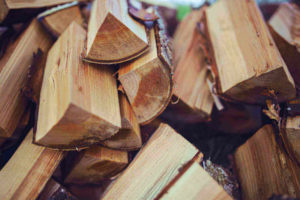Fall is here, and winter is right around the corner! As you prepare your fireplace for the burning season ahead, it is important to ensure you have the best firewood for your heating appliance. Many homeowners are surprised to learn that the firewood they use affect the safety and efficiency of their fireplaces. You have to purchase the right kind of firewood and store it correctly, these factors will improve your burning experience.
Types of firewood
 Firewood are divided into two main categories: hard woods and soft woods. Hard woods are dense, heavy. They come from trees who’s leaves change color each season. Ash, birch, maple, and oak are a few of the most popular hard woods. Hard woods make excellent firewood because they create fires that burns hotter while creating less smoke.
Firewood are divided into two main categories: hard woods and soft woods. Hard woods are dense, heavy. They come from trees who’s leaves change color each season. Ash, birch, maple, and oak are a few of the most popular hard woods. Hard woods make excellent firewood because they create fires that burns hotter while creating less smoke.
Soft woods come from evergreen trees with needles such as firs and pines. They tend to ignite quickly. This makes them ideal for kindling. However, they are known for creating large amounts of fragrant smoke, even when seasoned. This makes them ideal for outdoor firepits or when smoking meats.
Choosing the right firewood
The kind of firewood you choose often comes down to personal preference. No matter what kind of firewood you choose, it is important that the wood has been properly seasoned. Seasoned wood is wood that has been cut, stacked, and stored for at least six months to reduce the moisture content in it.
Seasoned firewood has significantly less moisture in it then freshly cut wood. Lowering the moisture content allows the firewood to ignite faster, burn hotter, and produce less smoke. Jack Pixley Chimney Sweeps and Masonry sells moisture meters. This tool shows the moisture content in seasoned firewood. Wood should have less than 20% moisture content to be burned indoors.
Drying wood in four easy steps
The EPA suggests four easy steps to correctly and easily dry your firewood.
- You must split the wood. Start by splitting large logs into uniform pieces. Having smaller logs in even sizes helps the wood dry faster.
- You need to stack them. Stack wood split side down on a dedicated firewood rack. Keep wood off the ground and away from buildings, this allows air to circulate through the wood pile and dry faster without rotting.
- You need to cover them. While the sides of the stack should remain open, cover the top of the firewood stack. This keeps moisture from rain and snow from seeping down to the stack.
- Then you need to store them properly. You need to give wood enough time to dry. Soft woods take around 6 months to dry when cut and stacked. Hard woods take upwards of 12 months before they are completely seasoned.
The kind of firewood you pick for your fireplace can really impact the efficiency and performance of your fire. This winter, make sure to burn wood that has been seasoned. For more information about seasoning firewood or purchasing a Moisture Meter, contact Jack Pixley Sweeps today!
